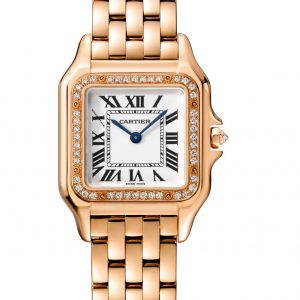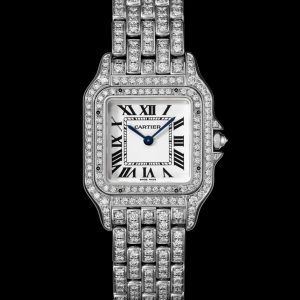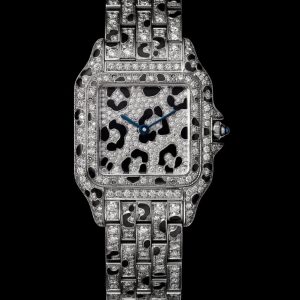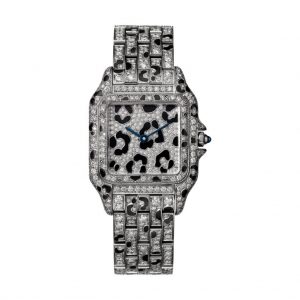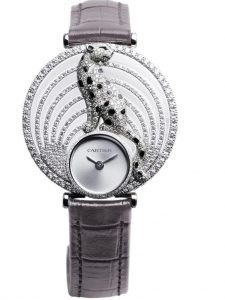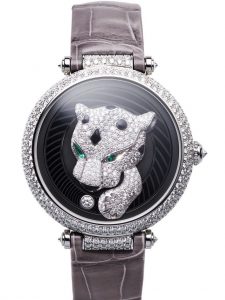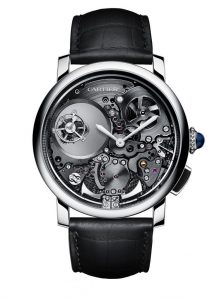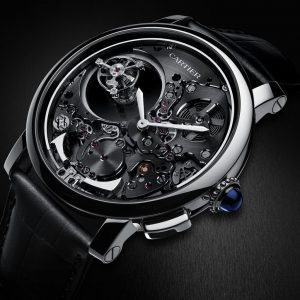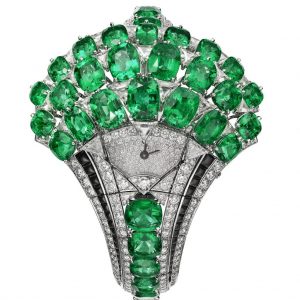We study the styling of the Cartier Rotonde de Replica Cartier Chronograph and test its in-house movement in this review from the watchesmanager.com archives. Original photos are by OK-Photography.
At first look, $9,050, the price of the Rotonde de Cartier Chronograph, seems to be a lot to pay for a steel chronograph. But it’s only a little higher than the cost of a Zenith El Primero or an IWC Portugieser chronograph. And while we’re comparing: the El Primero is a half century old already, and the ETA 7750 that runs the comparable Portugieser chronograph is almost that old and isn’t an in-house movement. Cartier unveiled its 1904-CH MC, the caliber inside the Rotonde de Cartier Chronograph, in 2013. Unlike the El Primero, it has a stop-seconds function. And although it doesn’t have a running seconds hand, its dial looks well balanced thanks to elapsed-time counters at 3 and 9 o’clock.
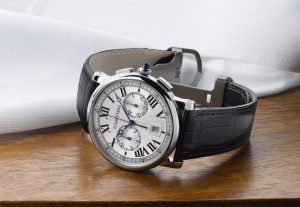
The 1904-CH MC is made so that the chronograph’s central elapsed-seconds hand can also be used as a running seconds hand. The two barrels maintain a constant level of drive torque independently of the winding status of their mainsprings, which ensures rate stability and precision. Our rate measurements show that the good rate continues when the chronograph is running. The results remain more or less identical after the cheap replica watches for sale has been allowed to run for 24 hours without additional winding. If the Rotonde de Cartier Chronograph is worn regularly, it will usually have fully wound mainsprings. The rotor, which turns smoothly in a sturdy ceramic ball bearing, winds the movement in both its directions of rotation. Bidirectional winding is achieved using an alternator with an innovative pawl-click system, which accelerates the winding speed.
The stopwatch function is controlled via a column wheel with vertical coupling. You can view the column wheel by peering through the sapphire window in the caseback and then looking even more deeply into the movement through an aperture in the upper bridge. The chronograph’s functions are triggered using two elongated push-pieces. Their large size makes the stopwatch easy to operate and the column wheel ensures that all switching sequences run smoothly.
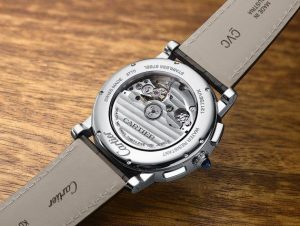
The zero-return function is blocked while the chronograph is running. Cartier achieved this by installing a linear heart lever inside the movement. The lever ensures the simultaneous return of all elapsed-time hands to their zero positions independently of the pressure exerted on the push-piece. The vertical coupling ensures that the chronograph starts and stops precisely. But despite the high technology, Cartier hasn’t ignored aesthetic finesse. In addition to Geneva waves and satin finishing, circular graining embellishes even the hidden sides of various components. The fine adjustment system for the balance is an eye-catcher, too: the C-shaped regulator with eccentric screw not only facilitates ultra-precise setting; it also underscores the brand’s identity.
Roman numerals on the dial and “Cartier” in signature type above the two subdials emphasize the brand’s identity, too. (It’s rather challenging to neatly print the brand’s name on the silver-plated and guilloché-embellished brass background.) A sunray pattern adorns the main dial, while concentric circles decorate the subdials. The minutes are counted along a railway-style circle using Arabic numerals at five-minute intervals; the hours are shown by Roman numerals and index strokes.
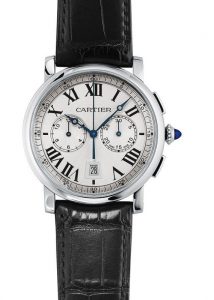
These details contrast with the satin-finished flange around the dial’s perimeter, where elapsed seconds are marked according to the 4-Hz rhythm of the caliber. Seconds are shown by a slim, needle-like hand, which complements the two Breguet-style hour and minutes hands. The result is a harmonious set of blued stainless-steel hands, which are easy to read by day. The blued hands match the pointed blue spinel cabochon atop the winding crown, another characteristic of Cartier watches. The crown is easy to grasp thanks to its shape and the beading around its edge. Both features enhance the sporty-elegance of the case. The large push-pieces and screw-fastened strap lugs look sporty, while elegance is seen in the conical lines of the middle part of the case, which tapers toward the back, where the sapphire window is affixed via screws. The case is water-resistant, but unfortunately only to 30 meters.
The women’s replica cartier watches has a high-quality leather strap that inserts without stops from both sides into a folding clasp that pivots on one side only. This lets the wearer customize the fit of the strap, which has a certain lightness and is comfortable to wear. It takes a bit of force to open the clasp, which responds to a strong tug on its bow, which is shaped like the “C” in the “Cartier” name.
